Initially, we set out the key findings of chapter 5. Note that referencing, data source and context is provided in the body of the chapter.
Key findings
- Of the working age population of Torbay (16 to 64), 76.6% are economically active and 23.4% are economically inactive, the latter of which is a couple of % higher than comparator geographies.
- Torbay has a higher % of residents who are ‘Managers, Directors and Senior Officials’ and a significantly lower % of residents who are in ‘Professional Occupations’. There is a similar profile for the workforce.
- The workforce of Torbay contains a higher % of those working in ‘Caring, Leisure and Service occupations’ and ‘Elementary occupations’ than surrounding geographies.
- Resident earnings underperform against the national lower quartile and median rates.
- All workforce income groups follow a similar trajectory which sees little or minimal growth from 2010 to 2018, in fact all groups see a dip from 2017 to 2018.
- Torbay ranks the 48th most deprived local authority in England out of a total of 317 local authorities, according to the Indices of Multiple Deprivation 2019.
- In both the 2016 and 2019 Indices of Multiple Deprivation, 16% of Torbay’s lower super output areas were in the 10% most deprived areas of England.
Economic activity in Torbay
The table below sets out the economic activity rates for the working age population in Torbay and comparative geographies based on the year until September 2021. The economic activity rate and the employment rate in Torbay is relatively consistent with the national picture.
| Rates | Torbay | Exeter | Plymouth | England ('000s) |
|---|---|---|---|---|
| Economic activity rate | 78.90% | 73.40% | 80.80% | 78.80% |
| Employment rate | 76.70% | 73.00% | 77.20% | 74.90% |
Source: ONS Annual Population Survey (Nomisweb) 2022
The table below shows the profile of economically active residents by occupational group within Torbay and surrounding geographies. The analysis is derived from the Annual Population Survey for the year covering Oct 2020 to Sep 2021. This data considers the occupation of residents of Torbay irrespective of the geographical area within which they work. The number of economically active residents in Torbay at the time of the survey was estimated at 59,900.
Torbay’s proportion of residents working in occupational group 1 (Manager, Directors and Senior Officials) is consistent with than the national profile but lower than Exeter.
Conversely Torbay exhibits a lower proportion of residents in occupational group 2 (Professional occupations) than comparative geographies. The proportion of Torbay residents in group 3 is also lower than for comparative geographies.
Aside from Plymouth, Torbay has a higher proportion of residents in occupation group 5 (Skilled
Trades Occupations). Torbay’s working residents are weighted toward the lower occupational groups when compared to both surrounding urban areas and nationally. It would be reasonable to assume that this would impact negatively on average resident earnings in Torbay. We will explore earnings later in this chapter.
| Group | Torbay no. | Torbay % | Exeter % | Plymouth % | England % |
|---|---|---|---|---|---|
| 1 Managers, Directors and Senior Officials | 6,400 | 10.7 | 14.7 | 8.3 | 10.9 |
| 2 Professional occupations | 9,300 | 15.5 | 25.4 | 17.8 | 23.4 |
| 3 Associated Prof. & Tech. Occupations | 5,900 | 9.9 | 11.3 | 16.7 | 15.6 |
| 4 Administrative and, Secretarial Occupations | 300 | 10.5 | 7.7 | 8.9 | 10.3 |
| 5 Skilled Trades, Occupations | 300 | 12.5 | 6.6 | 12.5 | 8.8 |
| 6 Caring, Leisure and Other Service Occupations | 6,200 | 10.3 | 13.5 | 12.2 | 9 |
| 7 Sales and Customer, Service Occupations | 800 | 9.7 | 5.7 | 8.6 | 6.9 |
| 8 Process, Plant and Machine Operatives | 3,600 | 6 | n/a | 6 | 5.6 |
| 9 Elementary Occupations | 9,100 | 15.2 | 14.7 | 9 | 9.2 |
Source: ONS Annual Population Survey 2022
The table below explores the profile of population working in Torbay by occupational group. It should be noted that these are workers that work in Torbay but do not necessarily live in Torbay. The analysis is derived from the Annual Population Survey for the year covering Oct 2020 to Sep 2021 as with the resident workforce.
The Torbay workforce consists of 58,200 persons according to the Annual Population Survey. This is slightly lower than the working or economically active population resident in Torbay at 59,900, hence Torbay is a net exporter of labour. This concurs with the findings in chapter 3 with reference to travel to work analysis (refer table 3.1).
In respect of its workforce, Torbay has a lower proportion of professional occupations (group 2) and associated professional and technical occupations (group 3) than surrounding geographies. Torbay also has a lower proportion of sales and customer service occupations than surrounding geographies.
Other areas of note are the higher proportion of Caring, Leisure and Other Service Occupations, and Elementary occupations in Torbay. Torbay is perceived as a relatively low wage economy which would chime with the proportions of the workforce in these lower occupational groups.
| Group | Torbay no. | Torbay % | Exeter % | Plymouth | England % |
|---|---|---|---|---|---|
| 1 Managers, Directors and Senior Officials | 6,600 | 11.3 | 11.5 | 8.3 | 11 |
| 2 Professional occupations | 11,500 | 19.8 | 29 | 23.3 | 23.5 |
| 3 Associated Prof. & Tech. Occupations | 5,800 | 10 | 13.5 | 14.1 | 15.6 |
| 4 Administrative and Secretarial Occupations | 6,700 | 11.5 | 7.5 | 7.9 | 10.3 |
| 5 Skilled Trades Occupations | 5,900 | 10.1 | 8.9 | 12.7 | 8.8 |
| 6 Caring, Leisure and Other Service Occupations | 6,800 | 11.7 | 11.2 | 10.3 | 9 |
| 7 Sales and Customer Service Occupations | 4,300 | 7.4 | 7.7 | 8.6 | 6.9 |
| 8 Process, Plant and Machine Operatives | 2,800 | 4.8 | 2.9 | 6.3 | 5.6 |
| 9 Elementary Occupations | 7,800 | 13.4 | 7.8 | 8.5 | 9.3 |
Source: ONS Annual Population Survey 2022
The graph below compares the number of Torbay residents in occupational groups (1 to 9) with
the number of Torbay’s workforce in the respective occupational groups. Where the graph shows that there are greater numbers of residents in an occupational group than the workforce, this indicates than Torbay is a net exporter of its labour within these occupational groups, and vice versa.
The graph shows that there are greater numbers of residents in occupational groups 5,7,8 and 9, the latter three traditionally being the lower waged occupational groups. This means a net number of the resident population of Torbay in these occupational groups will be working outside of the local authority area. The converse is true for occupational group 2, which is professional occupations, which indicates that Torbay imports more professional workers than it exports. The remainder show a similar number of residents and workforce.
Figure 5.1: Comparative no. of resident workers and workforce by occupational group.
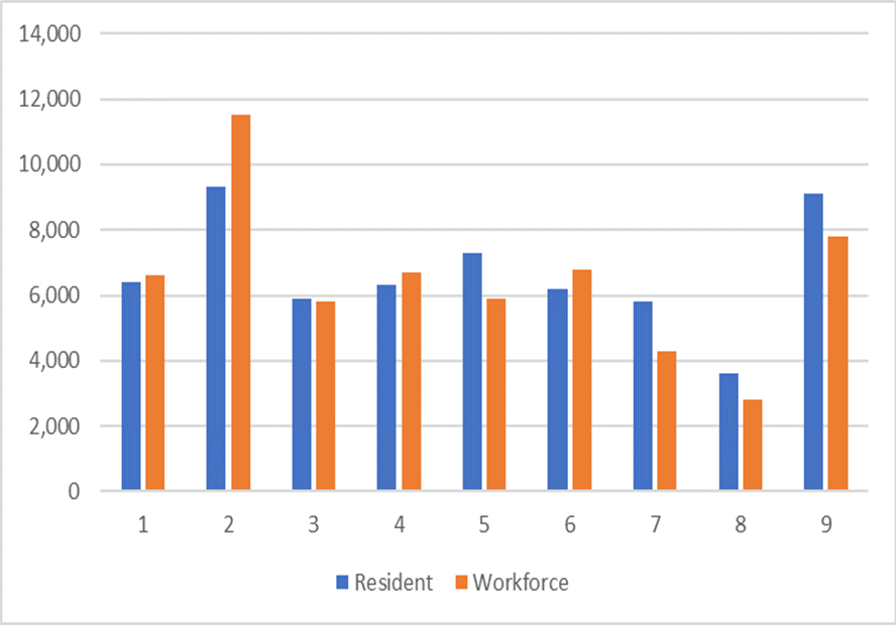
Source: ONS Annual Population Survey 2022
Earnings
We now consider the incomes of both the residents and workforce of Torbay. The data for this section is derived from Annual Survey of Hours and Earnings (ASHE) produced by the ONS which provides a snapshot of earnings in April of each year. The graph below shows the full-time incomes of the resident population across income ranges and the rate of increase over the last ten years. Earnings have been increasing steadily across the mean, median and lower quartile range since 2016. The lower quartile income range has jumped by over £2,000 from 2019 to 2020. This may have been prompted by the 6.2% National Living Wage increase which came into effect on 1 April 2020. Conversely tenth percentile earnings have plateaued from 2019 to 2020.
Figure 5.2 Full-time workers weekly pay gross- resident earnings
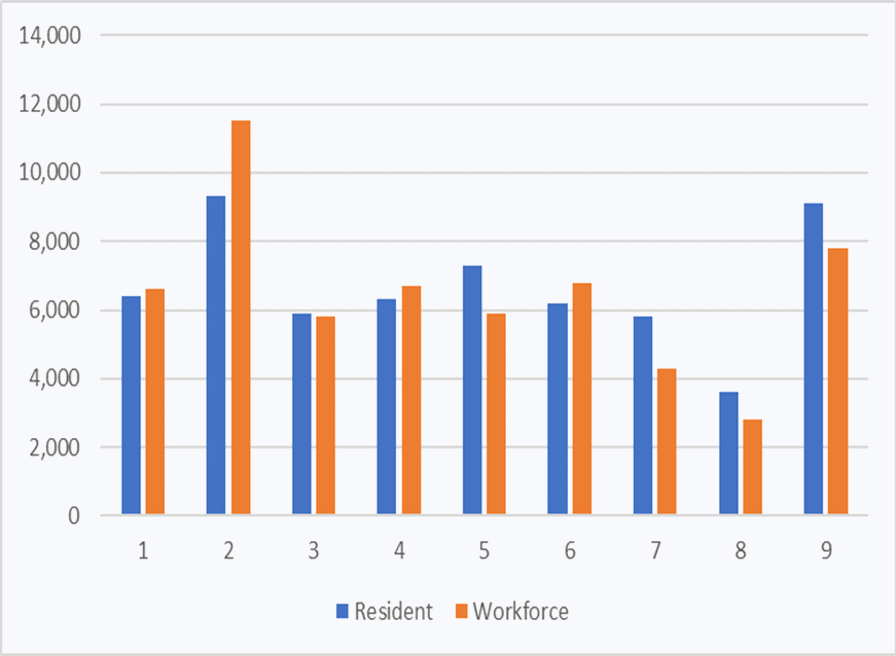
Source: ONS Annual Survey of Hours and Earnings 2021
The graphs (figures 5.3 and 5.4) below compare resident full-time annual earnings with comparative geographies and nationally. Resident earnings underperform against the national lower quartile (LQ) and median rates, as do Exeter and Plymouth, excepting Exeter exceeded the national LQ rate in 2019. Torbay lags Exeter over the ten-year period at both lower quartile and median income levels, excepting LQ rates in 2020. Over the period Torbay’s income levels have been lower than those in Plymouth, although the differentials have become far closer in recent years, and in 2020 Torbay LQ rates were higher than for Plymouth as well as for Exeter. The reasons for this reversal in 2020 are not clear. 2020 has seen the impact of lockdowns and Government support packages, the full impact of which has yet to play out.
Figure 5.3 Resident lower quartile full time earnings
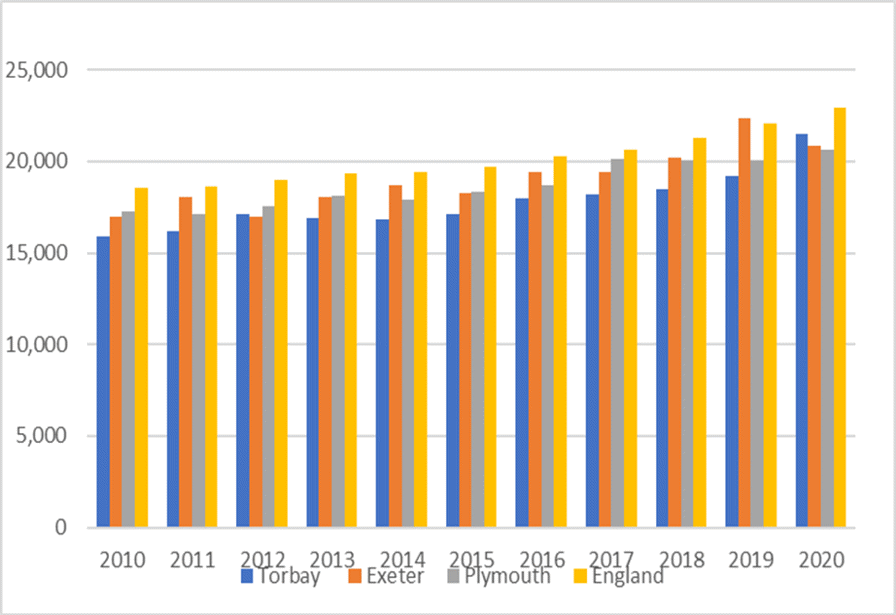
Source: ONS Annual Survey of Hours and Earnings 2021
Figure 5.4: Resident median full time earnings
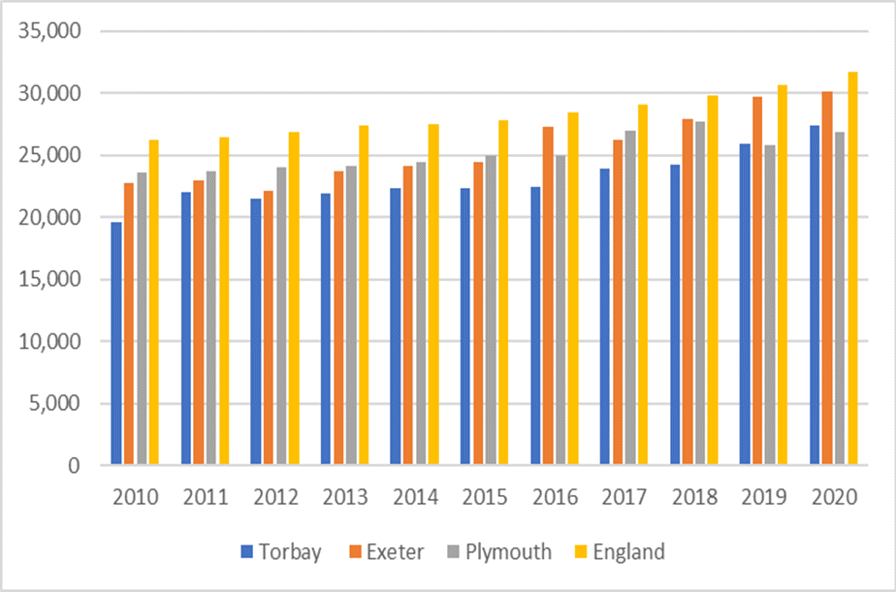
Source: ONS Annual Survey of Hours and Earnings 2021
The figure below shows ranges of annual earnings for the workforce in Torbay. These are across the median, mean, lower quartile (LQ) and tenth percentile ranges. There are some values missing from the ASHE data thereby explaining some missing columns most noticeably in 2016. All workforce income groups follow a similar trajectory which see little or minimal growth from 2010 to 2018. In fact, all groups see a dip from 2017 to 2018. However, 2019 and 2020 see consistent increases.
Figure 5.5: Workforce full time incomes
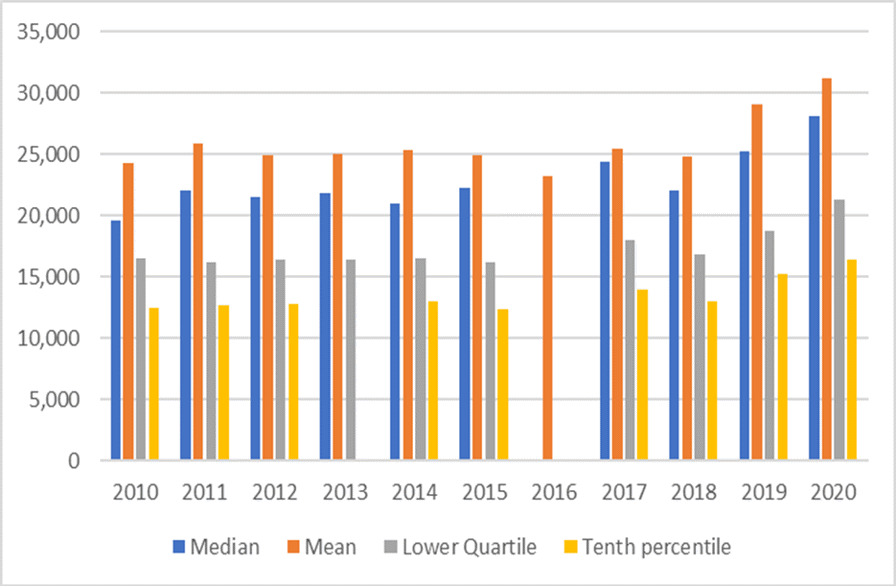
Source: ONS Annual Survey of Hours and Earnings 2021
Figure 5.6 compares workforce and resident full-time earnings in Torbay. Some housing market areas will see significant differentials between workforce income and resident incomes. For example in a commuter belt region outside of major conurbations, many residents will tend to commute to high paying positions in the neighbouring urban area, while workforce in the housing market area is likely to be heavily focussed on the service sector. This will lead to higher income ranges for residents than for the workforce. Conversely if a housing market area has a high wage employer, then the income range for the workforce may well exceed that of residents. Each housing market area can have a differing dynamic.
For Torbay, income ranges across the median, mean and lower quartile are relatively consistent across workforce and residents. This indicates that there is not a significant economic draw in or out of Torbay. Although we have established that Torbay is a net exporter of labour this may simply be due to the availability of employment as opposed to the draw of higher paid work.
Figure 5.6: Comparison between resident worker and workforce incomes
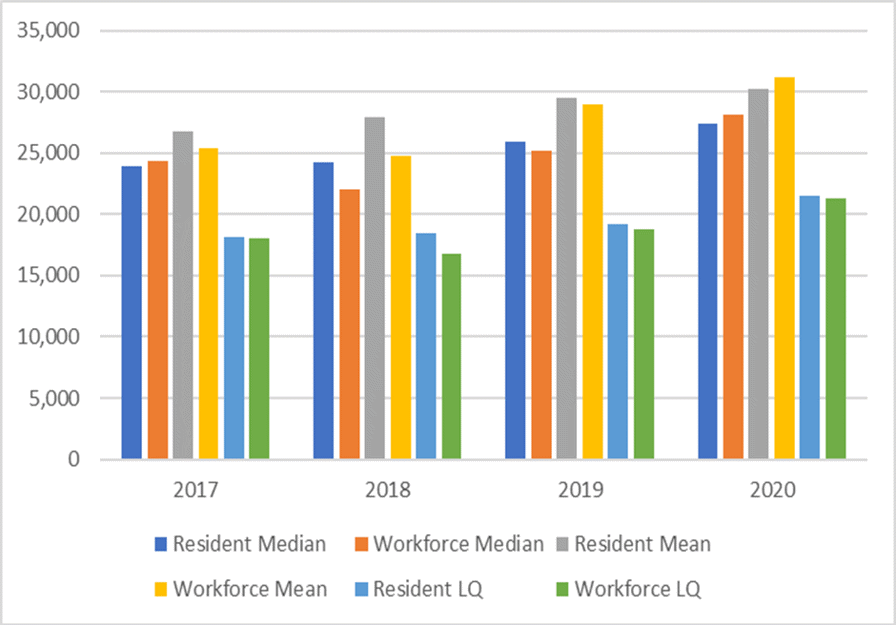
Source: ONS Annual Survey of Hours and Earnings 2021
Indices of multiple deprivation (IMD)
Torbay ranks the 48th most deprived local authority in England out of a total of 317 local authorities, according to the IMD 2019. Torbay also ranks 58th of 317 in terms of the proportion of lower super output areas (LSOAs) in the IMD first decile (most deprived). Torbay has significant deprivation in the town centre wards, particularly in Torquay and Paignton. In both the 2016 and 2019 IMD, 16% of lower super output areas (LSOAs) were in the 10% most deprived areas of England. As indicated in figure 5.7 the most deprived areas are in the Torquay and Paignton town centres, due in part to the significant numbers of low value private rented units in these areas.
In terms of the individual indices, income and employment deprivation are significant, with 11% of Torbay’s LSOAs being in the 10% most income deprived, and 17% being in the 10% most employment deprived LSOAs in England in the 2019 Index. Living environment deprivation improved somewhat between the 2015 and 2019 Index with 10% of Torbay’s LSOAs being in the 10% most deprived areas nationally in 2019, compared to 20% in 2015.
Figure 6.7: Indices of Multiple Deprivation 2019
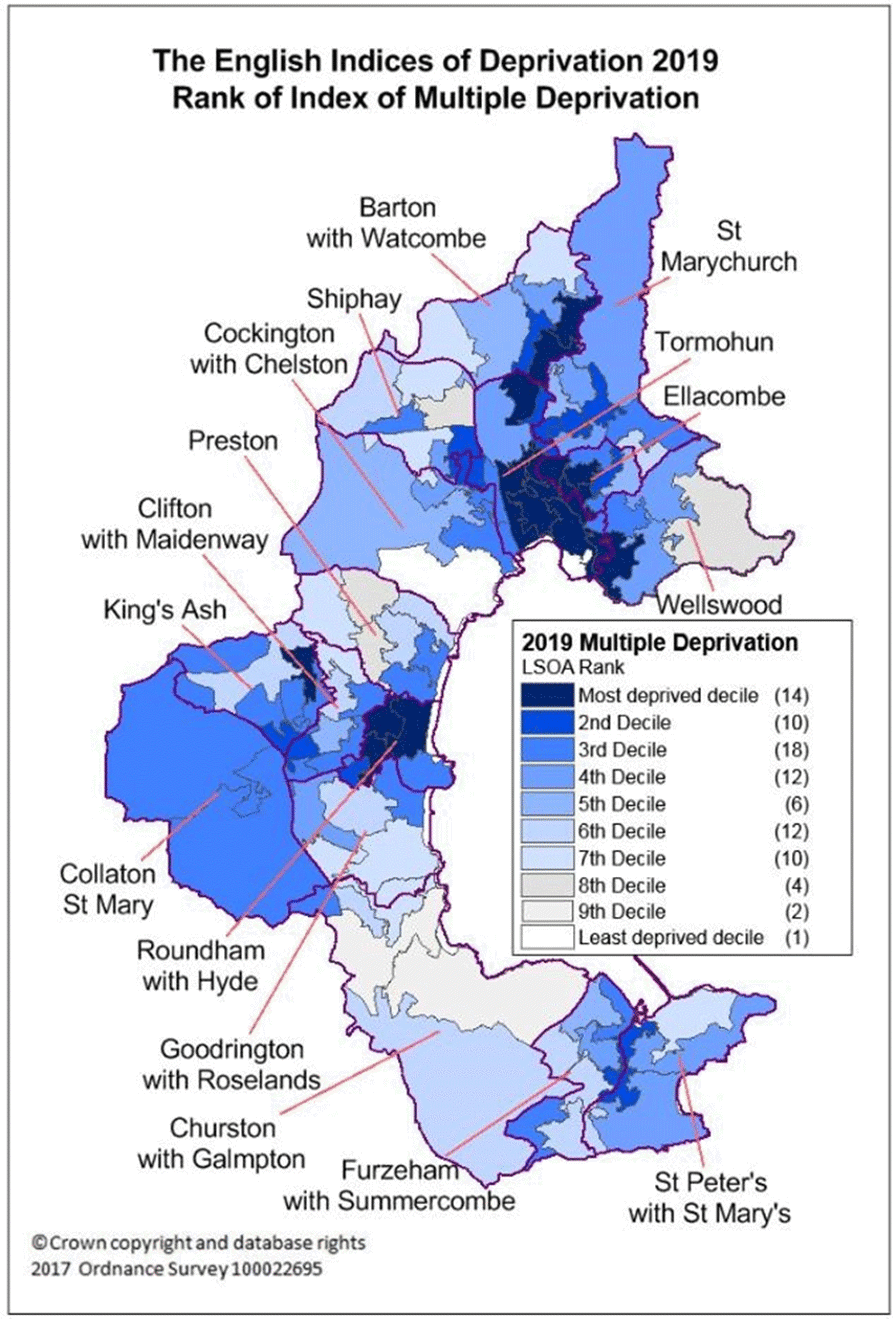
Source: ONS, Crown Copyright 2021
CACI Paycheck Data
The table below uses CACI paycheck data to compare household earnings in IMD deciles 1 and 2 with household earnings across Torbay as a whole, at the lower quartile (LQ), median and mean averages. It should be noted that CACI paycheck data reports gross household earnings whereas ASHE reports worker earnings. The table below indicates that gross LQ household income in LSOAs decile 1 and 2 is £14,600 and £16,079 respectively compared to a LQ household income across the whole of Torbay of £17,557. Proportionally LQ income in LSOAs in deciles 1 and 2 are 16.85% and 8.4% lower respectively than LQ income for Torbay as a whole. Proportionally median income in LSOAs in deciles 1 and 2 are 18.59% and 9.24% lower respectively than median income for Torbay as a whole.
| LSOA Torbay | IMD Decile | Count | CACI LQ | CACI Median | CACI Mean |
|---|---|---|---|---|---|
| 001B, 001E, 004A, 004D, 006A, 008A, 008B, 008C, 008D, 010A, 013G, 014B, 014C, 14D, | 1 | 11,494 | £14,600 | £24,758 | £30,469 |
| 001A, 002D, 004C, 005C, 006C, 013E, 014E, 017D, 018E, 019B | 2 | 6,472 | £16,079 | £27,601 | £33,521 |
| Torbay All | All deciles | 62,913 | £17,557 | £30,411 | £37,068 |
Source: CACI Ltd 2021
More in About the council
- How the council works
- Councillors
- Leader of the Council
- Get in touch
- Voting and elections
- Consultations
- Finance and budgets
- Plans, policies and strategies
- Information and data
- Civic Mayor
- Pay an invoice
- Report fraud within or against the council
- Audit
- Achievements, Honours and Awards
- Climate Change
- Our Performance
- Greener Way for Our Bay